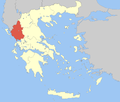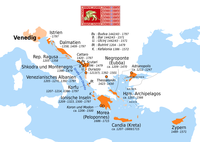Parga
Parga
Πάργα | |
|---|---|
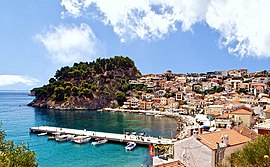 View of Parga | |
| Coordinates: 39°17′N 20°24′E / 39.283°N 20.400°E | |
| Country | Greece |
| Administrative region | Epirus |
| Regional unit | Preveza |
| Government | |
| • Mayor | Nikolaos Zacharias[1] (since 2019) |
| Area | |
| • Municipality | 274.8 km2 (106.1 sq mi) |
| • Municipal unit | 68.9 km2 (26.6 sq mi) |
| Elevation | 32 m (105 ft) |
| Highest elevation | 910 m (2,990 ft) |
| Lowest elevation | 0 m (0 ft) |
| Population (2021)[2] | |
| • Municipality | 10,762 |
| • Density | 39/km2 (100/sq mi) |
| • Municipal unit | 3,819 |
| • Municipal unit density | 55/km2 (140/sq mi) |
| • Community | 2,489 |
| Time zone | UTC+2 (EET) |
| • Summer (DST) | UTC+3 (EEST) |
| Postal code | 480 60 |
| Area code(s) | 26840 |
| Vehicle registration | ΡΖx |
| Website | parga.gr |
Parga (Greek: Πάργα, Párga, pronounced [ˈpaɾɣa]) is a town and municipality located in the northwestern part of the regional unit of Preveza in Epirus, northwestern Greece. The seat of the municipality is the village Kanallaki.[3] Parga lies on the Ionian coast between the cities of Preveza and Igoumenitsa. It is a resort town known for its natural environment.
Municipality
The present municipality of Parga was formed at the 2011 local government reform by the merger of the former municipalities of Fanari and Parga that became municipal units.[3]
The municipality has an area of 274.796 km2, the municipal unit 68.903 km2.[4]
History

In antiquity the area was inhabited by the Greek tribe of the Thesprotians. Mycenean tholos tombs have been discovered in the vicinity of Parga.[5] The ancient town of Toryne was located there during the late Hellenistic Age. It owes its name due to the shape of its beach (Greek: Τορύνη ladle in Greek).[6]
Parga itself is mentioned for the first time in 1318; the name is most likely of Slavic origin.[7] Two years later, the town and its sugarcane plantation proceeds were unsuccessfully offered by Nicholas Orsini, the Despot of Epirus, to the Republic of Venice in exchange for Venetian aid against the Byzantine Empire.[7] During the Epirote rebellion of 1338/39 against the Byzantine emperor Andronikos III Palaiologos, Parga remained loyal to the emperor.[7] The town came under the control of Albanian ruler Gjin Bua Shpata of Arta in the 1390s. Vonko, who was also vassal of the Venetians in Fanari, was the governor Parga at this time. After Shpata's death, he tried to carve his own fiefdom in 1400. The townspeople considered his rule tyrannical, overthrew him and asked the Venetians for protection.[8][7][9]
The town passed under Venetian control in 1401, and was administered as a mainland exclave of the Venetian possession of Corfu, under a castellan.[7] Ottoman raids were particularly heavy in the mid 15th century, as the senate gave the citizens of the town a 10-year tax exemption in 1454.[10] A Romaniote Jewish community was recorded in 1496 in Venetian Parga.[11]
Throughout the 16th century, Parga was part of the Venetian holdings in coastal Epirus. In 1570, anti-Ottoman rebels commanded by Emmanuel Mormoris that temporarily managed to overthrow Ottoman rule from the coastal regions of Epirus used Parga as a base of operations.[12] Venetian-controlled Parga was in this period in frequent property-related conflict with neighboring, Ottoman-controlled Margariti and was the target of constant raids.[13][14] The cause of friction has to do with the conflicting interests of the Venetians and the Albanian beys of Margariti for the control of the agricultural territory between the town of Parga and the inland territory. [15] Such an attack against the coastal port was organized in 1558 by the formerly Christian spahi of Agia (today part of the municipality of Parga) and the locals of the village who according to Venetian reports harassed Parga on a daily basis.[16] Relations between the two factions oscillated depending on political interests. The General Commander of the Venetian Fleet, Sebastiano Vernier (d. 1578) preferred a cautious policy of conflict resolution with the inhabitants of Margariti, as well as friendly relations with the Albanians loyal to Venice who controlled the area around Parga itself.[17] In the 17th century, their relations worsened and Parga was a frequent target of attacks by the beys of Margariti, in particular in 1640-42. During these two years, the representative (bailo) of Venice in the Ottoman court submitted an official note of protest for the attacks of Margariti against Venetian Parga.[18]
During Ottoman rule in Epirus, the inhabitants of Parga displayed continuous support for Greek revolutionary activities.[19] Apart from brief periods of Ottoman possession, the town remained in Venetian hands until the Fall of the Republic of Venice in 1797.[7] It then passed to France. As the relations of France with Ali Pasha deteriorated over his ambitions against the mainland exclave of Parga, the French twice considered using the men of their Albanian regiment against the mainland, but nothing came of these plans.[20] The leading figure of political life of Parga in this transitional period was Hasan Çapari, strong adversary of Ali Pasha and very wealthy landowner from nearby Margariti,[21] who in 1807 sought Russian support, claiming that the Royal Navy "were harassing the residents of Parga".[22] In 1812 the adjacent settlement of Agia that belonged to Parga was captured by Ottoman general Daut Bey, the nephew of Ali Pasha. He then massacred and enslaved the local population. Daut was killed during the following siege against Parga.[23] In 1815, with the fortunes of the French failing, the citizens of Parga revolted against French rule and sought the protection of the British. In 1819, the British ceded control the city to Ali Pasha of Ioannina (the subject of Francesco Hayez's later painting The Refugees of Parga) in exchange for a monetary settlement, and it later passed to full Ottoman rule. This decision was highly unpopular among the population of Parga, a predominantly Greek inhabited and extremely pro-Venetian settlement.[24] Parga then ceased to provide a refuge for Klephts and Souliotes and many residents of Parga moved to nearby Corfu rather than live under Ottoman rule.[25][26] As such Parga was completely abandoned by its inhabitants after the British departure and its handover to Ali Pasha in 1819.[27] Ali Pasha brought local Albanian speakers from Chameria to repopulate Parga.[27] In 1830, Ottoman general Kutahi pasha, in his attempt to restore rule and justice in the region, invited the people of Parga to return to their homeland.[28]
During the first year of the Greek War of Independence (1821) the Ottoman garrison of Parga was unsuccessfully attacked by a small force of Souliotes and men of the local diaspora.[29] In 1831 some Muslim refugee families from the Peloponnese were resettled in Parga by Reşid Mehmed Pasha[27] According to a 1877 report by the Greek vice-consul, in Parga lived 365 Christian and 180 Muslim families.[30] In 1877 the predominant language in Parga was Greek since even the local Muslim element spoke Greek, while some of them also spoke Albanian.[30] In the early 20th century, apart from Albanian speakers, a considerable part of the Parga Muslims were Greek speakers and Romani, many of whom had immigrated to the area from southern Greece after the Greek war of independence in 1821.[31] Ottoman rule in Parga and the rest of Epirus ended in 1913 following the victory of Greece in the Balkan Wars, and the town became part of Greece.[32] As a result of the Population exchange between Greece and Turkey, the state of Greece in November 1924 transported to Turkey, 1,500 Albanian-speaking Muslims from Parga, as not being of Albanian origin.[33] The Muslims of Parga had acquired Ottoman citizenship in 1913, but had later renounced it. On this basis, the Greek government considered them to be Turkish. As a result of protests, a Mixed Commission under the League of Nations with representatives from Greece and Albania was formed. On February 2, 1926, Qenan Mesare, the Albanian representative protested against the forced relocations to Turkey from the region of Chameria, the worsening of the living conditions for the Cham community and specifically referred to the village of Parga, where the majority were transferred to Turkey.[34] In 1927, a group of 20 Muslim families petitioned for their planned exchange to be annulled. This small group was eventually allowed to remain in Parga via mediation by the League of Nations which made their status "non-exchangeable".[35]
During the Axis Occupation of Greece, in August 1943, Parga was targeted by the German anti-guerilla operation named 'Augustus'. The Wehrmacht units were actively assisted by units of the Italian army and armed Cham Albanian groups under Nuri Dino, Mazar Dino and Abdul Qasim resulting in several Greek settlements to being burnt to the ground and the murder of civilian Greek population.[36] On August 10, 1943, the National Republican Greek League (EDES) and the Cham Balli Kombëtar (BK) held a meeting in Parga, attended by representatives of the two organizations including Mazar Dino. EDES asked for the disarmament of the Cham units and for their activity to pass under EDES command. These demands were met with refusal by the Cham BK.[37] After orders by the British Allied Command the EDES undertook operations around the coast of Parga. Control of the region was vital for logistical reasons.[38] On 28 June 1944, EDES took the village and killed 52 Cham Albanians.[39] The following month the left wing National Liberation Front (EAM) arrested 40 local Muslims and executed them. The remaining members of the Muslim community were saved by units of EDES.[40] In general violent incidents in Summer-Autumn 1944 were quite limited and the civilian Muslim community was not found in danger.[41] During the conflicts that resulted in the German retreat, the Axis troops around Parga had the armed support of Cham units.[38] At the end of the war, the remaining Muslim Chams fled to Albania.[42] Albanian is still spoken by a part of the inhabitants in of the municipality which includes a much broader area than the immediate vicinity of Parga itself.[43] In the settlements of the Fanari plain, Albanian is still spoken by a few people, while in some settlements like Anthousa and Kanallaki, the closest existing variants of Souliotic Albanian are still spoken by a few people in modern times.[44][45][46]
Various cultural and educational foundations in Parga were erected due to bequests by prominent locals, such as Athanasios Deskas.[47] The modern town in general preserves its traditional architectural features.[48]
Castle of Parga

The Castle is found on the top of a hill overlooking the town and was used to protect the town from invasions from the mainland and the sea. It was initially built in the 11th century by the residents of Parga to protect their town from pirates and the Ottomans. In the 13th century, as their control of the region increased, the Venetians rebuilt the castle to fortify the area. In 1452, Parga and the castle were occupied by the Ottomans for two years; part of the castle was demolished at that time. In 1537, Ottoman admiral Hayreddin Barbarossa burned and destroyed the fortress and the houses within.
Before the reconstruction of the castle in 1572 by the Venetians, the Turks demolished it once again. The Venetians rebuilt it for the third and last time creating a stronger fortress that stayed impregnable until 1819, despite attacks, especially by Ali Pasha of Ioannina. Provisions for the castle were transported via two bays at Valtos and Pogonia. When Parga was sold to the Ottomans, Ali Pasha made structural additions to the castle, including a Turkish bath and his harem quarters which he built at the top of the fortress. On the arched gate at the wall of the castle entrance, the winged lion of Agios Markos is visible. Other entrance details include, the name “ANTONIO BERVASS 1764”, emblems of Ali Pasha, two-headed eagles and related inscriptions.[49]
Geography

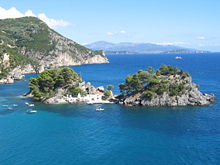
The city of Parga, built amphitheatrically, stands between the mountainous coastal region of Preveza and Igoumenitsa. It is known[by whom?] as the "Bride of Epirus". In the summer, tourists arrive from Paxos, Antipaxos, and Corfu by boat.[50]
Beaches
Parga attracts thousands of tourists. In its vicinity there are beaches including Valtos, Kryoneri, Piso Kryoneri, Lichnos, Sarakiniko and Ai Giannaki.[51]
Valtos Beach
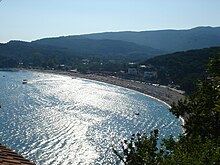
Valtos Beach is one of the longest beaches of Parga. It is located near the castle of Parga. Because of its clear waters and proximity to the town it attracts many tourists.[52] Kastro Point, which is located in the same beach, is popular among surfers due to its excellent surfing conditions. However, the level of skill required is high and the spot is best suited to more advanced surfers.[53]
Krioneri Beach
Krioneri Beach, the main beach of Parga, lies a short distance from the town centre. The small island of Virgin Mary is situated across the bay.[54]
Lichnos Beach

Lichnos Beach, one of the beaches of Parga,[55] is located in western Greece 3 km from Parga and Spread in the area of 2 hectares.[56]
Agios Sostis beach
Agios Sostis is a small beach on the northwest side of Anthoussa village. A small church, built in the 14th century, stands nearby.
Sarakiniko beach
Sarakiniko is a well-known beach, located on the west side of Agia village, near a small river and olive trees, approximately 12 km from the town centre. Small boats connect the beach with the port of Parga.
Climate
Parga experiences a hot-summer mediterranean climate (Köppen Csa). Precipitation falls mainly in the winter months, with little in the summer. The town experiences mild winters and hot, dry summers. The average annual temperature is 16.5 °C or 61.8 °F, with about 1219 mm or 48.0 inches of precipitation annually.[57]
Transport

The town of Parga is linked with direct suburban buses (KTEL) to other Greek cities and towns such as Igoumenitsa[58] and Preveza.[59] There are also indirect connections with Athens, Thessaloniki and Ioannina[59][60]
Tourists arriving in Parga fly in from Aktio (65 km) with seasonal direct flights connecting Parga with Athens, Thessaloniki and other domestic and international destinations. Tourists also arrive via the Ioannina and Corfu airports.
Parga is located 10 km from national road ![]() and 34 km from national motorway
and 34 km from national motorway ![]() .
.
Municipal districts
- Agia (Agia, Sarakiniko)
- Anthousa (Anthousa, Trikorfo)
- Livadari (Livadari, Vryses)
- Parga (Parga, Agia Kyriaki, Agios Georgios, Maras, Chrysogiali)
Historical population
| Year | Town | Municipal unit | Municipality |
|---|---|---|---|
| 1981 | 1,892 | - | - |
| 1991 | 1,699 | 3,569 | - |
| 2001 | 2,432 | 4,033 | - |
| 2011 | 2,415 | 3,904 | 11,866 |
| 2021 | 2,489 | 3,819 | 10,762 |
Notable people
- Pargalı Ibrahim Pasha (1493–1536), a grand vizier in the Ottoman Empire
- Andreas Idromenos (1764–1843), scholar[61]
- Panagiotis Aravantinos (1811–1870), historian and scholar
- Ioannis Dimoulitsas, fighter of the Greek War of Independence
- Tus, (1986–present), Greek rapper
See also
References
- ^ "Municipality of Parga, Municipal elections – October 2023". Ministry of Interior.
- ^ "Αποτελέσματα Απογραφής Πληθυσμού - Κατοικιών 2021, Μόνιμος Πληθυσμός κατά οικισμό" [Results of the 2021 Population - Housing Census, Permanent population by settlement] (in Greek). Hellenic Statistical Authority. 29 March 2024.
- ^ a b "ΦΕΚ A 87/2010, Kallikratis reform law text" (in Greek). Government Gazette.
- ^ "Population & housing census 2001 (incl. area and average elevation)" (PDF) (in Greek). National Statistical Service of Greece.
- ^ Papadopoulos, Thanasis (1995). "A Late Mycenaean Koine in Western Greece and the Adjacent Ionian Islands". Bulletin of the Institute of Classical Studies. 40 (Supplement_63): 201–208. doi:10.1111/j.2041-5370.1995.tb02112.x. ISSN 0076-0730.
- ^ Hammond, N.G.L. (1997). "Physical Features and Historical Geography". Epirus, 4000 Years of Greek History and Civilization: 291. ISBN 9789602133712.
- ^ a b c d e f Soustal, Peter; Koder, Johannes (1981). Tabula Imperii Byzantini, Band 3: Nikopolis und Kephallēnia (in German). Vienna: Verlag der Österreichischen Akademie der Wissenschaften. pp. 226–227. ISBN 978-3-7001-0399-8.
- ^ Osswald 2011, p. 230.
- ^ Asonitis, Spyros (1999). "Σχέσεις της Βενετικής διοίκησης της Κέρκυρας με τις ηγεμονίες του Ιονίου (1386-1460)". Peri Istorias. 2: 30. doi:10.12681/p.i..24736.
Μια σύντομη αναφορά εγγράφου του Ιστορικού Αρχείου της Κέρκυρας, που μας πληροφορεί ότι το 1400 οι Κερκυραίοι... εξασφάλιζε στο κάστρο αυτό η Βενετία
- ^ Osswald 2011, p. 303:En 1454, Parga subit des dégâts si importants que la République accorda aux habitants de la ville une exemption d’impôts d’une durée de dix ans
- ^ Osswald 2007, p. 130.
- ^ Vranousis, L.; Sfyroeras, V. (1997). "From the Turkish Conquest to the Beginning of the Nineteenth Century: Revolutionary Movements and Uprisings". Epirus, 4000 Years of Greek History and Civilization: 244–251. ISBN 9789602133712.
- ^ Amoretti, Guido (2007). " The Serenissima Republic in Greece: XVII- XVIII Centuries : from the Drawings of Captain Antonio Paravia and the Archives of Venice. Omega. p. 160.
This was a typical border town, which like so many of its neighbours, was in a constant state of conflict with the Albanians .
- ^ Xhufi., Pëllumb (2017). Arbërit e Jonit (eng: The Albanians of the Ionian Sea). Onufri. pp. 993–994.
- ^ Psimuli 2016, p. 76-77: The aghas and beys of Margariti (Margëlliç) were by default enemies of the Venetians because they were concerned by a possible Venetian inland expansion via the increase of the hinterland of Parga which meant reduction of the vital space of the [beys] of Margariti in lands of high agricultural value in particular. For this reason, raids and attacks against the lands of Parga were continuous. Similar activity is attested in 1640-42, when the Venetian bailo submitted an official note of protest to the Ottoman court. The raids of the Muslim Albanian clans headed by the beys of Margariti continued throughout the next century against Parga and repeatedly took the form of direct warfare.
- ^ Psimuli 2016, p. 65.
- ^ Xhufi., Pëllumb (2017). Arbërit e Jonit (eng: The Albanians of the Ionian Sea). Onufri. p. 994.
si deve considerar bene di conservar li Albanesi, che sono venuti alla devotion di Vostra Serenita, quali possedono detti terreni
- ^ Psimuli 2016, p. 77.
- ^ Fleming, K. E. (14 July 2014). The Muslim Bonaparte: Diplomacy and Orientalism in Ali Pasha's Greece. Princeton University Press. pp. 70–71. ISBN 978-1-4008-6497-3.
Parga, Vonitza, Preveza, and Butrinto. In 1401 the peoples of Parga had established the precedent of colluding with Venice by placing themselves voluntarily under Venetian protection, thus staying the advance of the Ottomans... These territories came to be known for their staunch support of the Greek revolutionary causeand Parga colluded with the independent Orthodox peoples of Souli in their chronic battles with Ali Pasha.
- ^ Pappas, Nicholas Charles (1982). Greeks in Russian Military Service in the Late Eighteenth and Early Nineteenth Centuries. Stanford University. pp. 265, 388.
Kolokotrones claims that Ali Farmaki and he recruited 3000 Chams, who gathered at Parga to embark first to Lefkas and Zante and then hence to the Peloponnesus, only to have the whole plan aborted by the English capture of Zante (...)
- ^ Balta, Oğuz & Yaşar 2011, p. 364.
- ^ Frary, Lucien (2019). "The Russian consulate in the Morea and the outbreak of the Greek Revolution, 1816-21". In Suonpää, Mika; Wright, Owain (eds.). Diplomacy and Intelligence in the Nineteenth-Century Mediterranean World. Bloomsbury Publishing. pp. 59–63. ISBN 978-1474277051.
Vlassopoulos's diplomacy focused on defending the neighbouring population of Parga, whose leader, Hasan Agha Tsapari, had sought Russian support... Weeks later, Vlassopoulos reported that British naval vessels were harassing the residents of Parga, who were seeking protection from the tsar.
- ^ Russell, Eugenia; Russell, Quentin (30 September 2017). Ali Pasha, Lion of Ioannina: The Remarkable Life of the Balkan Napoleon. Pen and Sword. p. 86. ISBN 978-1-4738-7722-1.
- ^ Amoretti, Guido (2007). The Serenissima Republic in Greece: XVII- XVIII Centuries : from the Drawings of Captain Antonio Paravia and the Archives of Venice. Omega. p. 160.
The inhabitants, who were mostly Greeks and extremely loyal to the Venetian flag, refused to become Moslem subjects and decided to abandon their home .
- ^ Dakin, Douglas (1973). The Greek Struggle for Independence, 1821-1833. University of California Press. p. 45. ISBN 978-0-520-02342-0.
- ^ Jim Potts (2010). The Ionian Islands and Epirus: A Cultural History. Oxford University Press. p. 154. ISBN 978-0-19-975416-8.
- ^ a b c Kokolakis, Mihalis (2003). Το ύστερο Γιαννιώτικο Πασαλίκι: χώρος, διοίκηση και πληθυσμός στην τουρκοκρατούμενη Ηπειρο (1820–1913) [The late Pashalik of Ioannina: Space, administration and population in Ottoman ruled Epirus (1820–1913)]. Athens: EIE-ΚΝΕ. p. 189. ISBN 960-7916-11-5. "Χωριστή περιφέρεια αποτέλεσε αρχικά και η πόλη της Πάργας. Όπως είναι γνωστό, η Πάργα ανήκε από το 1800 στα εξαρτήματα του προνομιούχου βοϊβοδαλικιού της Πρέβεζας, όπου εντάχθηκαν οι ηπειρωτικές κτήσεις της άλλοτε βενετικής δημοκρατίας αντίθετα όμως με την Πρέβεζα, κατόρθωσε από το 1807 να υποβληθεί πρώτα στη γαλλική και μετά στην αγγλική προστασία. Με την άρση της τελευταίας (1819) η πόλη, ολοκληρωτικά εγκαταλειμμένη από τους κατοίκους της, παραδόθηκε στον Αλή πασά. Ο τελευταίος την εποίκισε με ντόπιους αλβανόφωνους της Τσαμουριάς, στους οποίους ο Κιουταχής θα προσθέσει το 1831 αρκετές οικογένειες μουσουλμάνων προσφύγων της Πελοποννήσου."
- ^ Gounaris, Basil C. (14 December 2018). "Blood Brothers in Despair: Greek Brigands, Albanian Rebels and the Greek-Ottoman Frontier, 1829‑1831". Cahiers balkaniques. 45: 9. doi:10.4000/ceb.11433. S2CID 164455295. Retrieved 10 December 2021.
- ^ Nikolaidou, Eleftheria (1997). "Epirus and the Greek War of Independence". Epirus, 4000 Years of Greek History and Civilization: 275. ISBN 9789602133712.
- ^ a b Skoulidas, Ilias (2001). The Relations Between the Greeks and the Albanians During the 19th Century: Political Aspirations and Visions (1875–1897). Didaktorika.gr (Thesis). University of Ioannina. p. 81. doi:10.12681/eadd/12856. hdl:10442/hedi/12856.
Έτσι ο διευθύνων το υποπροξενείο της Πάργας σημείωνε ότι.... Επικρατούσα γλώσσα ήταν η ελληνική καθώς και οι μουσουλμάνοι μιλούσαν ελληνικά' προέρχονταν από την περιοχή του Λόλα στην Πελ/σο
- ^ Tsoutsoumpis, Spyros (December 2015). "Violence, resistance and collaboration in a Greek borderland: the case of the Muslim Chams of Epirus". Qualestoria (2): 121. Retrieved 14 June 2016.
While the majority of local Muslims were Albanian-speakers, there was a significant presence of Roma and Greek-speaking Muslims in the towns of Parga and Paramithia, many of whom had emigrated from southern Greece after the 1821 revolution
- ^ [1] Archived December 5, 2011, at the Wayback Machine
- ^ Tsitselikis, Konstantinos (2012). Old and New Islam in Greece: From Historical Minorities to Immigrant Newcomers. Martinus Nijhoff Publishers. p. 442. ISBN 978-9004221529.
- ^ Sadik, Blerina (2018). "Population Exchange between Greece and Turkey". In Motta, Giuseppe (ed.). Dynamics and Policies of Prejudice from the Eighteenth to the Twenty-first Century. Cambridge Scholars Publishing. ISBN 978-1527517004.
He referred to the case of Parga, where the majority of the population was forced to relocate to Turkey
- ^ Tsitselikis, Konstantinos (2012). Old and New Islam in Greece: From Historical Minorities to Immigrant Newcomers. Martinus Nijhoff Publishers. p. 442. ISBN 978-9004221529.
- ^ Γκότοβος, Αθανάσιος (2013). "Ετερότητα και σύγκρουση: ταυτότητες στην κατοχική Θεσπρωτία και ο ρόλος της Μουσουλμανικής μειονότητας". Επιστημονική Επετηρίδα Τμήματος Φιλολοσοφίας, Παιδαγωγικής, Ψυχολογίας. 36. University of Ioannina, Dodoni Journal: 45. Archived from the original on 2017-02-17. Retrieved 2020-10-29.
Αφορά εκκαθαριστικές επιχειρήσεις στην περιοχή νοτίως της Παραμυθιάς, μέχρι την Αμμουδιά και την Πάργα...
- ^ Isufi 2002, p. 249:Në vargun e përpjekjeve të EDES - it dhe të Ballit Kombëtar çam për të përfunduar bisedimet e lëna pezull, është edhe takimi që u zhvillua në Pargë, më 10 gusht 1943 me përfaqësuesit e të dyja palëve . (..) Përfaqësuesit e Napolon Zervës kërkonin me këmbëngulje që pala çame e Ballit të plotësonte këto kërkesa : 1. Të bëhej çarmatimi i menjëhershëm i çamëve dhe gjithë forcat çame të armatosura si dhe ato të afta për luftë, të kalonin nën nën komandën e EDES - it
- ^ a b Kondis, Basil (1 January 1995). "The Greek minority in Albania". Balkan Studies. 36 (1): 83–102. ISSN 2241-1674. Retrieved 25 November 2020.
in Epirus, the British Allied Mission decided that Zervas should take the coast around Parga (which was controlled by the Tchams) so that the National Democratic Greek League (EDES) could more easily receive supplies from small craft from Italy. Armed bands of Tchams fought side- by-side with the Germans during these operations, particularly around Parga, Paramythia, and Igoumenitsa
- ^ Petrov, Bisser (2009). "National Republican Greek League EDES". Études balkaniques. 45 (3–4). Academy of Sciences of Bulgaria: 30.
On June 27, 1944, EDES units overran the town of Paramythia and killed about 600 Albanians. On the next day, another EDES battalion reached Parga and killed another 52.
- ^ Tsoutsoumpis, Spyros (December 2015). "Violence, resistance and collaboration in a Greek borderland: the case of the Muslim Chams of Epirus". Qualestoria (2): 137. Retrieved 14 June 2016.
- ^ Γκότοβος, Αθανάσιος (2013). "Ετερότητα και σύγκρουση: ταυτότητες στην κατοχική Θεσπρωτία και ο ρόλος της Μουσουλμανικής μειονότητας". Επιστημονική Επετηρίδα Τμήματος Φιλολοσοφίας, Παιδαγωγικής, Ψυχολογίας. 36. University of Ioannina, Dodoni Journal: 45, 65. Archived from the original on 2017-02-17. Retrieved 2020-10-29.
...την Πάργα και τους Φιλιάτες το καλοκαίρι και το Φθινόπωρο του 1944 ήταν εξαιρετικά περιορισμένα, και αυτό επειδή τελικά ο Ζέρβας μπόρεσε να επιβάλει την αναγκαία πειθαρχία για την περιφρούρηση του συγκεντρωμένου σε διάφορα ασφαλή σημεία άμαχου μουσουλμανικού πληθυσμού
- ^ Mazower, Mark (2000). "Three Forms of Political Justice, 1944-1945". After The War Was Over: Reconstructing the Family, Nation and State in Greece, 1943–1960 (illustrated ed.). Princeton, New Jersey: Princeton University Press. pp. 25–26. ISBN 9780691058429. Retrieved 15 March 2009.
- ^ Elsie, Robert (2010). Historical dictionary of Albania. Lanham: Scarecrow Press. p. 173. ISBN 978-0-8108-7380-3. OCLC 659564122.
- ^ Psimuli 2016, pp. 180–81
- ^ Baltsiotis, Lambros (2014). "Balkan Roma immigrants in Greece: An initial approach to the traits of a migration flow". International Journal of Language, Translation and Intercultural Communication. 2: 19. doi:10.12681/ijltic.47.
- ^ Tsoutsoumpis, Spiros (2016). A history of the Greek resistance in the Second World War: The people's armies. Manchester University Press. p. 51. ISBN 978-1526100931.
- ^ Ploumidis, G. (1997). "Cultural Life in Epirus". Epirus. Ekdotike Athenon: 418. ISBN 9789602133712.
The overwhelming majority of the bequests were to Ioannina, followed by ... Parga... Many school buildings are due to bequests:... Thanasis Deskas at Parga
- ^ Κωστάρα, Αικατερίνη-Διονύσιος (2004). "Η τουριστική ανάπτυξη των ακτών από την πόλη της Πρέβεζας έως την πόλη της Ηγουμενίτσας" (in Greek). p. 68. Retrieved 4 November 2020.
- ^ [2] Archived August 28, 2011, at the Wayback Machine
- ^ [3] Archived August 27, 2011, at the Wayback Machine
- ^ "Beaches of Parga | ΔΗΜΟΣ ΠΑΡΓΑΣ : ΕΠΙΣΗΜΗ ΙΣΤΟΣΕΛΙΔΑ". Archived from the original on August 27, 2011. Retrieved November 13, 2011.
- ^ "Valtos Beach". Municipality of Parga. Archived from the original on August 26, 2011. Retrieved November 13, 2011.
- ^ "Kastro Point, Parga Surfing". AlternativeSpots. Archived from the original on 2021-06-22. Retrieved 2021-04-01.
- ^ "Krioneri Beach | ΔΗΜΟΣ ΠΑΡΓΑΣ : ΕΠΙΣΗΜΗ ΙΣΤΟΣΕΛΙΔΑ". Archived from the original on August 28, 2011. Retrieved November 13, 2011.
- ^ "Beaches For Camping In Europe". Retrieved March 29, 2018.
- ^ "Lichnos Beach |} ΔΗΜΟΣ ΠΑΡΓΑΣ : ΕΠΙΣΗΜΗ ΙΣΤΟΣΕΛΙΔΑ". Archived from the original on August 25, 2011. Retrieved November 30, 2011.
- ^ "Parga climate: Average Temperature, weather by month, Parga water temperature - Climate-Data.org". en.climate-data.org. Retrieved 2023-03-19.
- ^ "Αρχική Σελίδα". Ktel-thesprotias.gr. Retrieved 2015-07-30.
- ^ a b "ΚΤΕΛ ΝΟΜΟΥ ΠΡΕΒΕΖΑΣ Α.Ε. :: Καλώς ήλθατε". Ktelprevezas.gr. Retrieved 2015-07-30.
- ^ "йтек иыаммимым а.е". Ktelioannina.gr. Archived from the original on 2020-01-21. Retrieved 2015-07-30.
- ^ "Ιδρωμένος Ανδρέας". Kapodistrias.info. Retrieved 8 September 2021.
Sources
- Balta, Evangelia; Oğuz, Mustafa; Yaşar, Filiz (2011). "Εthnic and Religious Composition of Ottoman Thesprotia in the 15th to 17th centuries". In Forsén, Björn; Tikkala, Esko (eds.). Thesprotia Expedition II. Environment and Settlement Patterns. Foundation of the Finnish Institute at Athens. ISBN 978-952-67211-2-5.
- Isufi, Hajredin (2002). Musa Demi dhe qëndresa çame: 1800-1947. Botime Dudaj. ISBN 9992750103.
- Ψιμούλη, Βάσω Δ. (2006). Σούλι και Σουλιώτες. Ιστορία και Πολιτική (4th ed.). Athens: Βιβλιοπωλείον της Εστίας.
- Psimuli, Vaso Dh. (2016). Suli dhe suljotët [Souli and the Souliots]. Toena. ISBN 9789928205728.
- Osswald, Brendan (2007). "The Ethnic Composition of Medieval Epirus". In Ellis, Steven G.; Klusáková, Lud'a (eds.). Imagining Frontiers, Contesting Identities. Pisa: Edizioni Plus – Pisa University Press. ISBN 978-88-8492-466-7.
- Osswald, Brendan (2011). L'Epire du treizième au quinzième siècle : autonomie et hétérogénéité d'une région balkanique (Thesis). Université Toulouse le Mirail - Toulouse II.



